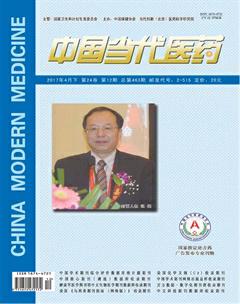甲狀腺未分化癌的遺傳學改變研究進展
趙佳正
[摘要]甲狀腺未分化癌是一種惡性程度很高的腫瘤,區別于分化型甲狀腺癌,常規的手術、放療及化療治療效果較差。隨著甲狀腺未分化癌分子發病機制的不斷研究,許多遺傳學改變都被認為參與了甲狀腺未分化癌發生、發展的過程,為甲狀腺未分化癌的分子靶向治療提供了新的可能。本文將介紹與甲狀腺未分化癌發病相關的遺傳學改變的研究進展,主要包括RAS/RAF/MAPK/ERK信號通路和PI3K/Akt mTOR信號通路。
[關鍵詞]甲狀腺未分化癌;分子機制;基因
[中圖分類號] R736.1 [文獻標識碼] A [文章編號] 1674-4721(2017)04(c)-0016-04
[Abstract]As a highly malignant tumor,anaplastic thyroid carcinoma is different from differentiated thyroid cancer,conventional surgery,radiotherapy and chemotherapy can achieve poor results in the treatment of thyroid undifferentiated carcinoma.With the unceasing research on molecular pathogenesis of anaplastic thyroid carcinoma,many genetic changes are thought to be involved in the development process of anaplastic thyroid carcinoma and to provide a new possibility for molecular targeted treatment of thyroid undifferentiated carcinoma.In this paper,the research progress of the genetic changes related to the pathogenesis of anaplastic thyroid carcinoma is introduced,including RAS/RAF/MAPK/ERK signaling pathway and PI3K/Akt mTOR signaling pathway.
[Key words]Anaplastic thyroid carcinoma;Molecular mechanism;Gene
近年來甲狀腺癌的發病率不斷上升,已經成為最常見的內分泌腫瘤[1]。根據甲狀腺癌病理組織類型,可分為乳頭狀甲狀腺癌(papillary thyroid cancer,PTC)、濾泡狀甲狀腺癌(follicular thyroid cancer,FTC)、低分化型甲狀腺癌(poorly differentiated thyroid cancer,PDTC)和甲狀腺未分化癌(anaplastic thyroid carcinoma,ATC),其中PTC和FTC又被稱為分化型甲狀腺癌(differentiated thyroid cancer,DTC)。ATC是一種惡性程度很高的腫瘤,在所有甲狀腺癌中占2%~15%,導致了絕大多數的甲狀腺癌相關死亡,中位生存期為6個月,臨床表現為迅速增長的頸部腫塊,常常伴隨壓迫癥狀[2-3]。ATC常具有高度侵襲性,容易發生腺體外侵犯及淋巴結轉移,60%的患者有遠處轉移,ATC的TNM分期均為Ⅳ期[3]。在過去的幾十年中,ATC生存的改善微乎其微[4],也正因為如此,對ATC分子發病機制的研究就顯得尤為重要。研究人員試圖通過遺傳學改變的研究找到治療ATC的新途徑。
甲狀腺癌惡性程度進展被認為是一個多步驟的腫瘤發生過程,甲狀腺濾泡細胞早期發生的RAS、BRAF導致分化型甲狀腺癌的發生,而p53基因失活突變導致了細胞進一步失分化而出現甲狀腺低分化癌(PDTC)和ATC[5]。與ATC發生相關的基因組改變主要包括RAS/RAF/MAPK/ERK信號通路、PI3K/Akt mTOR信號通路[5-6],下面將按照遺傳學改變的類型(基因突變、基因重排和基因拷貝數增加)分類闡述。
1基因突變
1.1 Ras突變
Ras家族包括K-ras、H-ras及N-ras,Ras位于RAF/MAPK及PI3K/Akt mTOR的上游,Ras突變會導致這兩條通路異常活化[7]。RAS突變常見于濾泡性甲狀腺癌,但在PTC和ATC中也有報道[8]。在對甲狀腺癌的組織病理研究中,發現高達60%的ATC出現Ras突變,而在PTC中突變率<15%,PDTC中突變率為30%~35%[9],可見Ras突變頻率與分化程度成負相關。在甲狀腺癌發展的過程中,RAS似乎是一個“早期”突變,RAS突變被認為啟動了DTC到ATC這個去分化過程,因為RAS突變會使細胞發生基因和分子錯排,例如導致染色體不穩定[10]。
1.2 BRAF突變
RAF家族包括ARAF、BRAF和CRAF 3種亞型。BRAF是Raf絲氨酸/蘇氨酸激酶家族中的一員,是Ras的下游效應器,在正常甲狀腺細胞增殖、凋亡及甲狀腺特異基因表達中起重要的調節作用[11]。研究顯示,大鼠甲狀腺細胞中BRAF基因突變及隨后的MAPK的活化能沉默鈉/碘協同轉運體(sodium/iodide symporter,NIS)的表達,而通過siRNA去除BRAF突變可以恢復甲狀腺特異性基因的表達[12],BRAFV600E突變被證實會阻礙NIS基因的表達以及NIS的膜定位,而通過抑制BRAF,可逆轉NIS轉錄抑制[12]。BRAFV600E突變可導致DTC細胞中甲狀腺特異蛋白表達下調,促進去分化,還與轉移和侵襲相關[13]。基于BRAF突變在DTC以及DTC轉化成ATC中發揮重要作用,BRAF突變成為治療ATC的研究靶點[14]。
1.3 PI3K突變
磷脂酰肌醇3-激酶(phosphatidylinositol 3-kinage,PI3K)為脂激酶家族,參與細胞增殖、存活。磷脂酰肌醇3-激酶/蛋白激酶B/哺乳動物雷帕霉素靶蛋白(phosphatidylinositol 3-kinage/protein kinase B/mammaliantarget of rapamycin,P13K/Akt mTOR)信號通路與ATC的發生、發展密切相關[15],其中的PI3K突變是最常見的突變,ATC中PI3K突變發生的頻率遠高于PTC[7]。PI3K突變可通過抑制cAMP而降低NIS表達,使得甲狀腺癌細胞向未分化方向發展,同時PI3K突變可上調下游的mTOR含量,mTOR可促進細胞增殖、抑制細胞凋亡,mTOR又可以降低NIS表達[16]。
1.4 p53突變
p53是一種抑癌基因,編碼的蛋白質分子量為53 kDa,是一種轉錄因子,p53抑癌基因在調節細胞周期和細胞凋亡中的起重要作用[17]。p53基因在DTC中突變頻率低而在ATC中突變頻率可高達95%,在并發PTC和ATC的病理組織中,可在ATC組織中檢測到p53突變,而在PTC中檢測不到[18]。有學者提出了“兩步機制”,甲狀腺癌中,在BRAF突變的細胞基礎上發生p53基因的突變,使得腫瘤失分化,p53突變的出現是一個晚期事件,其使得腫瘤轉化和去分化而變得更具侵略性[19-20]。目前,針對p53的靶向治療已成為研究熱點。
1.5 β-catenin基因突變
β-catenin是一種多功能蛋白分子,分布于細胞質中,高達60%~65%的ATC中存在β-catenin突變[21]。在ATC中,β-catenin基因突變主要涉及Wnt/β-catenin通路以及與E-cadherin/β-catenin相關的細胞黏附系統。β-catenin在細胞增殖和細胞黏附中都發揮作用。Wnt/β-catenin通路中過度表達的β-catenin會進入細胞核內,引起細胞持續增殖;E-cadherin/β-catenin的細胞黏附系統中β-catenin突變會使細胞間黏附力減弱,進而增加腫瘤細胞的侵襲性[22]。
1.6 Notch
Notch受體(Notch1-4)及其配體不同情況下可調節細胞的增殖,遷移、黏附和分化[23]。Ferretti等[24]首次證實,與正常甲狀腺組織相比,Notch在DTC中表達明顯降低,而在ATC中進一步降低,Notch 1對細胞生長和分化的影響是通過調控基因轉錄來實現。雖然在其他組織和癌癥中有許多研究,但Notch 1在甲狀腺癌中的作用最近才被探索。作為Notch 1下游效應分子,Hes 1在甲狀腺細胞增殖和分化中起中心作用,在Hes 1(-/-)小鼠胚胎中,甲狀腺表面積減少了34%~65%,NIS蛋白減少69%[25]。
1.7 NF-κB
核因子κB(NF-κB)屬于轉錄因子家族,可被多種促炎細胞因子、化療藥物和電離輻射激活[26]。許多NF-κB靶基因是促生存基因,對癌細胞固有的化療和放射治療抵抗至關重要,體外和體內各種腫瘤細胞包括甲狀腺癌在內的研究中,通過抑制NF-κB活性會導致細胞凋亡或增強化療和放射治療的敏感性[27]。在PTC、FTC及ATC中均發現NF-κB被激活,因此,抑制NF-κB的活化被認為可通過腫瘤細胞的內在和外在機制加強化療和放射治療的作用[28]。
2基因重排
RET原癌基因位于染色體10q11.21,其包含了21個外顯子,編碼一跨膜的絡氨酸激酶受體,包含了1114個氨基酸[29]。目前文獻共報道了13種甲狀腺癌 RET/PTC基因重排,發生RET/PTC基因重排后會導致RET基因的持續活化,進而活化下游的RAS基因,RET/PTC基因重排會導致染色體不穩定,使細胞失分化[30]。另一個常見的易位是TRK-fused(TFG)和受體酪氨酸激酶NTRK 1,類似于RET的染色體重排,一些TFG的融合蛋白同樣會導致MAPK激酶過度激活[31]。
3基因拷貝數增加
受體酪氨酸激酶(receptor tyrosine kinase,RTK)是最大的一類酶聯受體,包括了50余種,而常見的表皮生長因子受體(epidermal growth factor receptor,EGFR)、血小板生長因子受體(platelet-derived growth factor receptor,PDGFR)、血管內皮生長因子受體(vascularendothelial growth factor receptor,VEGFR)等突變與多種腫瘤的發生相關[32]。在ATC中,RTK的突變并不常見,但RTK基因拷貝數的增加較為常見。一項研究發現,ATC中發生相應基因拷貝數增加的頻率分別為:EGFR 46.3%,PDGFR 23.9%,VEGFR 45.5%,而PIK3C基因拷貝數增加的頻率為38.3%[33]。
總之,ATC惡性程度高,預后差,至今仍未找到較好的治療手段,傳統的手術、化療、放療效果都不理想,而分子機制的研究發現,ATC中存在多種基因突變及基因異常擴增,這些分子機制的研究或許能為該病的治療提供新的思路。
[參考文獻]
[1]Haugen BR,Alexander EK,Bible KC,et al.2015 American thyroid association management guidelines for adult patients with thyroid nodules and differentiated thyroid cancer:the American Thyroid Association Guidelines Task Force on Thyroid Nodules and Differentiated Thyroid Cancer[J].Thyroid,2016,26(1):1-133.
[2]馮影,高明.94例甲狀腺未分化癌臨床分析[J].天津醫科大學學報,2008,14(2):207-209.
[3]Smallridge RC,Ain KB,Asa SL,et al.American thyroid association guidelines for management of patients with anaplastic thyroid cancer[J].Thyroid,2012,22(11):1104-1139.
[4]Bisof V,Rakusic Z,Despot M.Treatment of patients with anaplastic thyroid cancer during the last 20 years:whether any progress has been made?[J].Eur Arch Otorhinolaryngol,2015,272(7):1553-1567.
[5]Xu B,Ghossein R.Genomic landscape of poorly differentiated and anaplastic thyroid carcinoma[J].Endocr Pathol,2016, 27(3):205-212.
[6]Lennon P,Deady S,Healy ML,et al.Anaplastic thyroid carcinoma:failure of conventional therapy but hope of targeted therapy [J].Head Neck,2016,38(1):E1122-E1129.
[7]Santarpia L,El-Naggar AK,Cote GJ,et al.Phosphatidylinositol 3-kinase/akt and ras/raf-mitogen-activated protein kinase pathway mutations in anaplastic thyroid cancer[J].J Clin Endocrinol Metab,2008,93(1):278-284.
[8]Gupta N,Dasyam AK,Carty SE,et al.RAS mutations in thyroid FNA specimens are highly predictive of predominantly low-risk follicularpattern cancers[J].J Clin Endocrinol Metab,2013,98(1),E914-E922.
[9]Basolo F,Pisaturo F,Pollina LE,et al.N-ras mutation in poorly differentiated thyroid carcinomas:correlation with bone metastases and inverse correlation to thyroglobulin expression[J].Thyroid,2000,10(1):19-23.
[10]Howell GM,Hodak SP,Yip L.RAS mutations in thyroid cancer[J].Oncologist,2013,18(2):926-932.
[11]Rushton S,Burghel G,Wallace A,et al.Immunohistochemical detection of BRAF V600E mutation status in anaplastic thyroid carcinoma[J].Histopathology,2016,69(2):524-526.
[12]Riesco-Eizaguirre G,Rodríguez I,De la Vieja A,et al.The BRAFV600E oncogene induces transforming growth factor beta secretion leading to sodium iodide symporter repression and increased malignancy in thyroid cancer[J].Cancer Res,2009,69(21):8317-8325.
[13]Lim AM,Taylor GR,Fellowes A,et al.BRAF inhibition in BRAFV600E-positive anaplastic thyroid carcinoma[J].J Natl Compr Canc Netw,2016,14(3):249-254.
[14]Latteyer S,Tiedje V,Konig K,et al.Targeted next-generation sequencing for TP53,RAS,BRAF,ALK and NF1 mutations in anaplastic thyroid cancer[J].Endocrine,2016,54(3):733-741.
[15]Liu Z,Hou P,Ji M,et al.Hishly prevalent genetic alterations in receptor tyrosine kinases and phosphatidylinositol 3-kinase/Akt and mitogen-activated protein kinase pathways in anaplastic and follicllar thyroid cancers[J].J Clin Endocrinol Metab,2008,93(5):3106-3116.
[16]Zhang P,Wang C,Ma T,et al.O-GlcNAcylation enhances the invasion of thyroid anaplastic cancer cells partially by PI3K/Akt1 pathway[J].Onco Targets Ther,2015,8(1):3305-3313.
[17]Blagosklonny MV,Giannakakou P,Wojtowicz M,et al.Effects of p53-expressing adenovirus on the chemosensitivity and differentiation of anaplastic thyroid cancer cells[J].J Clin Endocrinol Metab,1998,83(1):2516-2522.
[18]Spitzweg C.Gene therapy in thyroid cancer[J].Horm Metab Res,2009,41(6):500-509.
[19]Soares P,Lima J,Preto A,et al.Genetic alterations in poorly differentiated and undifferentiated thyroid carcinomas[J].Curt Genomies,2011,12(1):609-617.
[20]Mc Fadden DG,Vernon A,Santiago PM,et al.p53 constrains progression to anaplastic thyroid carcinoma in a Braf-mutant mouse model of papillary thyroid cancer[J].Proc Natl Acad Sci USA,2014,111(16):E1600-E1609.
[21]Garcia-Rostan G,Tallini G,Herrero A,et al.Frequent mutation and nuclear localization of beta-catenin in anaplastic thyroid carcinoma[J].Cancer Res,1999,59(8):1811-1815.
[22]Xing M.Molecular pathogenesis and mechanisms of thyroid.cancer[J].Nat Rev Cancer,2013,13(3):184-199.
[23]Kim HJ,Kim MJ,Kim A,et al.The role of notch 1 signaling in anaplastic thyroid carcinoma[J].Cancer Res Treat,2017, 49(2):509-517.
[24]Ferretti E,Tosi E,Po A,et al.Notch signaling is involved in expression of thyrocyte differentiation markers and is down-regulated in thyroid tumors[J].J Clin Endocrinol Metab,2008,93(10):4080-4087.
[25]Li J,Zheng X,Gao M,et al.Suberoyl bis-hydroxamic acid activates Notch 1 signaling and induces apoptosis in anaplastic thyroid carcinoma through p53[J].Oncol Rep,2017,37(3):458-464.
[26]Miyamoto S.Nuclear initiated NF-κB signaling:NEMO and ATM take center stage[J].Cell Res,2011,21(3):116-130.
[27]Meng Z,Lou S,Tan J,et al.Nuclear factor-kappa B inhibition can enhance the rapeutic efficacy of 131I on the in vivo management of differentiated thyroid cancer[J].Life Sci,2012,91(5):1236-1241.
[28]Yin Q,Liu S,Dong A,et al.Targeting transforming growth factor-beta 1 (TGF-beta 1) inhibits tumorigenesis of anaplastic thyroid carcinoma cells through ERK1/2-NF kappa B-PUMA signaling[J].Med Sci Monit,2016,22(1):2267-2277.
[29]Romei C,Elisei R.Ret/ptc translocations and clinico-pathological features in human papillary thyroid carcinoma[J].Front Endocrinol (Lausanne),2012,(3):54.
[30]Kimura ET,Nikiforova MN,Zhu Z,et al.High prevalence of BRAF mutations in thyroid cancer:genetic evidence for constitutive activation of the RET/PTC-RAS-BRAF signaling pathway in papillary thyroid carcinoma[J].Cancer Res,2003,63(1):1454-1457.
[31]Greco A,Miranda C,Pierotti MA.Rearrangements of NTRK1 gene in papillary thyroid carcinoma[J].Mol Cell Endocrinol,2010,28,321(1):44-49.
[32]Antonelli A,Bocci G,Fallahi P,et al.CLM3,a multitarget tyrosine kinase inhibitor with antiangiogenic properties,is active against primary anaplastic thyroid cancer in vitro and in vivo[J].J Clin Endocrinol Metab,2014,99(1):E572-E581.
[33]Liu Z,Hou P,Ji M,et al.Highly prevalent genetic alterations in receptor tyrosine kinases and phosphatidylinositol 3-kinase/akt and mitogen-activated protein kinase pathways in anaplastic and follicular thyroid cancers[J].J Clin Endocrinol Metab,2008,93(1):3106-3116.
(收稿日期:2017-03-14 本文編輯:祁海文)

